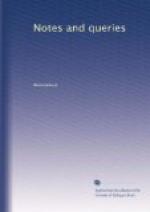“A Bill of fare for a Gentleman’s House about Candlemas.
“1. A Pottage with
a Hen. 2. A Chatham-pudding. 3. A
Fricacie
of Chickens. 4. A leg
of mutton with a Sallet. Garnish your
dishes with Barberries.
“Second Course.
1. A chine of Muton. 2. A chine of Veal.
3.
Lark-pye. 4. A couple
of Pullets, one larded. Garnished with
orange slices.
“Third Course.
1. A dish of Woodcocks. 2. A couple of Rabbits.
3. A dish of Asparagus.
4. A Westphalia Gammon.
“Last Course.
1. Two orange tarts, one with herbs. 2. A
Bacon
Tart. 3. An apple Tart.
4. A dish of Bon-chriteen pears. 5. A
dish of Pippins. 6. A
dish of Pearmains.
“A Banquet for the same Season.
“1. A dish of Apricots.
2. A dish of marmalade of Pippins. 3. A
dish of preserved Cherries.
4. A whole red Quince. 5. A dish of
dryed sweet-meats.
“A Bill of Fare upon an extraordinary Occasion.
“1. A collar of brawn. 2. A couple of Pullets boyled. 3. A bisk of Fish. 4. A dish of Carps. 5. A grand boyled Meat. 6. A grand Sallet. 7. A venison pasty. 8. A roasted Turkey. 9. A fat pig. 10. A powdered Goose. 11. A haunch of Venison roasted. 12. A Neats-tongue and Udder roasted. 13. A Westphalia Ham boyled. 14. A Joll of Salmon. 15. Mince pyes. 16. A Surloyn of roast beef. 17. Cold baked Meats. 18. A dish of Custards.
“Second Course. 1. Jellies of all sorts. 2. A dish of Pheasants. 3. A Pike boyled. 4. An oyster pye. 5. A dish of Plovers. 6. A dish of larks. 7. A Joll of Sturgeon. 8. A couple of Lobsters. 9. A lamber pye. 10. A couple of Capons. 11. A dish of Partridges. 12. A fricacy of Fowls. 13. A dish of Wild Ducks. 14. A dish of cram’d chickens. 15. A dish of stewed oysters. 16. A Marchpane. 17. A dish of Fruits. 18. An umble pye.”
The fare suggested for “Fish days” is no less various and abundant; twelve dishes are enumerated for the first course, and sixteen for the second. Looking at the character of these viands, some of which would not discredit the genius of a Soyer or a Mrs. Glasse, {55} it seems pretty evident that in the article of food the labouring classes have been the greatest gainers since 1687.
Few things are more suggestive of queries—as everybody knows from experience—than the products of culinary art. I will not, however, further trespass on space which may be devoted to a more dignified topic, than by submitting the following.
Query.—Does the phrase “to eat humble pie,” used to signify a forced humiliation, owe its origin to the “umble pye” specified above?
J.T. HAMMACK
* * * * *
BISHOP BARNABY.




